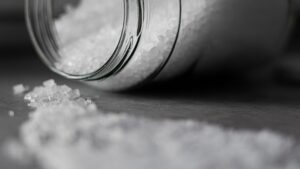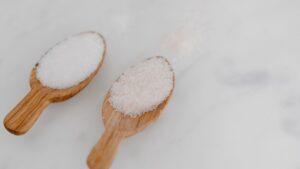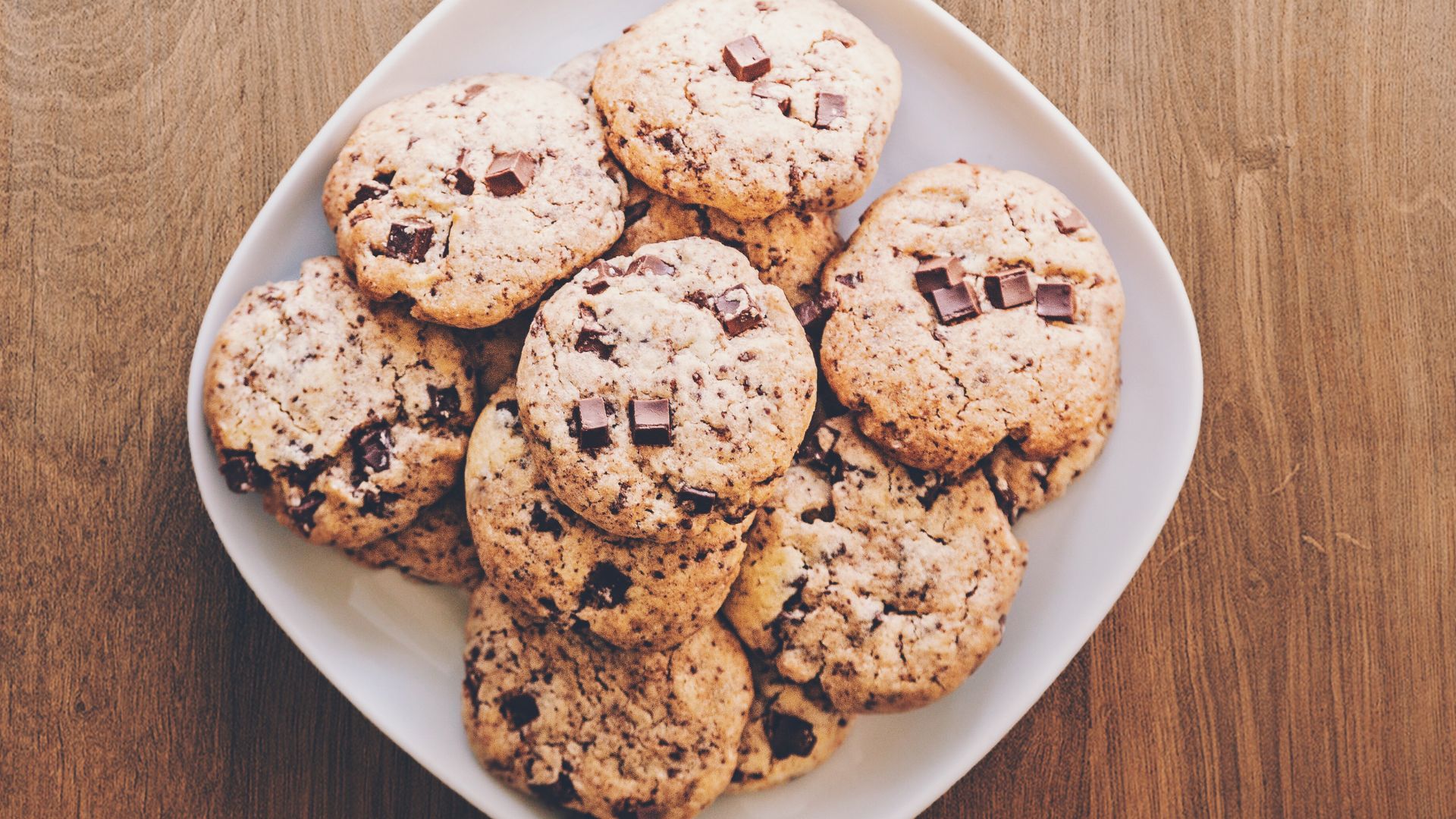Table of Contents
ToggleWhat is Sea Salt (SB)?
Sea salt is harvested through the evaporation of seawater, which means it retains various minerals that table salt doesn’t have. These minerals can add a unique flavor and texture to your baked goods. Unlike table salt, which is finely ground and often treated with anti-caking agents, sea salt usually comes in larger crystals and has a more natural, unprocessed feel. == >> Check out the right cookies Sea salts, tools and ingredients that you need here

The Role of Sea Salt in Cookie Making
Sea salt isn’t just for sprinkling on top of cookies for a decorative touch. Here’s how it plays a key role in baking:
1. Enhances Flavor
Sea salt enhances the overall flavor of cookies. The subtle crunch of sea salt crystals against the sweet, buttery dough creates a delightful contrast. This interplay of sweet and salty can elevate the taste experience, making your cookies stand out.== >> Check out the right cookies Sea salts, tools and ingredients that you need here
2. Balances Sweetness
Sometimes, cookie recipes can end up overly sweet. A pinch of sea salt can balance out the sweetness by adding a layer of complexity to the flavor profile. This balance helps ensure that the cookies taste well-rounded and not cloyingly sweet.
3. Adds Texture
The larger crystals of sea salt provide a pleasant crunch and texture that is different from the uniform texture of table salt. This crunch can make each bite more interesting and enjoyable.== >> Check out the right cookies Sea salts, tools and ingredients that you need here

4. Enhances Other Ingredients
Sea salt can also amplify the flavors of other ingredients in your cookies. For instance, it can highlight the richness of chocolate or the nuttiness of browned butter. This enhancement happens because salt interacts with taste buds and amplifies the natural flavors in food.== >> Check out the right cookies Sea salts, tools and ingredients that you need here
How to Use Sea Salt in Your Cookie Recipes
1. Choose the Right Type
When choosing sea salt for cookies, opt for a flaky or coarse variety. These types have a larger crystal size that provides the desirable crunch and burst of flavor.
2. Use Sparingly
A little sea salt goes a long way. Generally, a small pinch sprinkled on top of cookies before baking is sufficient. If you’re incorporating sea salt into the dough, start with a small amount and adjust according to taste.
3. Experiment with Timing
Sprinkling sea salt on top of cookies just before baking can give you a beautiful visual effect and a burst of flavor. You can also try mixing a small amount into the dough for a more even distribution of saltiness.== >> Check out the right cookies Sea salts, tools and ingredients that you need here
Incorporating sea salt into cookie recipes is a simple yet effective way to enhance the flavor and texture of your cookies. Its ability to balance sweetness, add a unique texture, and amplify other ingredients makes it a valuable addition to your baking toolkit. Next time you bake cookies, consider reaching for sea salt and experience the difference it can make.

Sea Salt in Cookie Making: Examples and Tips
Having explored how sea salt enhances your cookie recipes, it’s helpful to see some practical examples of how to use it effectively. Here are a few tried-and-true methods for incorporating sea salt into your cookie creations, along with some examples that showcase its impact.
Examples of Sea Salt in Cookie Recipes
1. Salted Chocolate Chip Cookies
One of the most popular ways to use sea salt is in classic chocolate chip cookies. After baking, sprinkle a small pinch of sea salt on top of each cookie while they’re still warm. This simple step creates a delightful contrast between the sweet, gooey chocolate and the crunchy, salty topping. It’s a small touch that makes a big difference, enhancing the overall flavor experience.== >> Check out the right cookies Sea salts, tools and ingredients that you need here
2. Sea Salt Caramel Cookies
For a more adventurous recipe, try sea salt caramel cookies. These cookies incorporate caramel pieces or a swirl of caramel sauce in the dough. By adding sea salt on top before baking, you create a sophisticated flavor profile that balances the rich, buttery caramel with a touch of saltiness. This technique highlights the caramel’s sweetness while adding depth and complexity to the cookie.
3. Rosemary Sea Salt Cookies
For a unique twist, consider making rosemary sea salt cookies. This recipe combines fresh rosemary with sea salt for a savory-sweet treat. The sea salt brings out the rosemary’s aromatic qualities, creating a fragrant and flavorful cookie that pairs wonderfully with a cup of tea or coffee. Just mix finely chopped rosemary into the dough and sprinkle a bit of sea salt on top before baking.== >> Check out the right cookies Sea salts, tools and ingredients that you need here
4. Sea Salt and Dark Chocolate Cookies
Dark chocolate cookies with sea salt offer a rich and sophisticated flavor combination. The slightly bitter taste of dark chocolate is complemented by the sea salt’s crunch and saltiness. For a finishing touch, sprinkle a pinch of sea salt over the cookies right after they come out of the oven. This contrast between dark chocolate and sea salt is a sure way to impress any cookie lover.== >> Check out the right cookies Sea salts, tools and ingredients that you need here
Pro Tips for Using Sea Salt in Cookies
1. Adjust According to Taste
Different sea salts have varying levels of saltiness. If you’re using a particularly coarse or flaky sea salt, start with a smaller amount and taste as you go. Remember, it’s easier to add more salt than to try to fix over-salted dough.
2. Consider the Salt’s Size
The size of the sea salt crystals can affect both flavor and texture. Larger crystals will create more noticeable bursts of saltiness, while smaller crystals will blend more evenly into the dough. Choose according to your desired result, whether you want a subtle flavor enhancement or a more pronounced salty crunch.
3. Store Properly
Sea salt should be stored in a cool, dry place to maintain its quality and prevent clumping. A sealed container is ideal to keep it fresh and ensure it’s always ready for your baking adventures.
4. Experiment with Different Types
There are many types of sea salt, from fleur de sel to Himalayan pink salt. Each type has its own unique flavor and texture. Don’t be afraid to experiment with different varieties to find the one that best complements your cookie recipes.== >> Check out the right cookies Sea salt tools and ingredients that you need here
Drilling Deeper: Sea Salt vs. Table Salt in Cookie Making
When it comes to baking cookies, the choice of salt can make a notable difference. Let’s drill deeper into the comparison between sea salt and table salt to understand their unique characteristics and how they impact your cookies.
Sea Salt vs. Table Salt: Key Differences
1. Composition and Texture
- Sea Salt: Sea salt is harvested from evaporated seawater and often contains a variety of minerals, which can contribute to its unique flavor and texture. It usually comes in larger crystals, which can add a pleasant crunch to your cookies. The mineral content can also add subtle nuances to the flavor profile of your baked goods.
- Table Salt: Table salt is typically mined from salt deposits and is highly processed to remove impurities and minerals. It has a fine, uniform texture, which can dissolve quickly into cookie dough. This makes it less likely to provide the same textural contrast as sea salt. Additionally, table salt often contains additives to prevent clumping, which can affect its taste.== >> Check out the right cookies Sea salt tools and ingredients that you need here
2. Flavor Impact
- Sea Salt: The larger crystals of sea salt can provide bursts of flavor and enhance the overall taste of cookies. Its varied mineral content can also add depth and complexity to the flavor, making it an excellent choice for recipes where you want to emphasize the saltiness.
- Table Salt: Table salt has a more consistent and straightforward saltiness due to its fine texture. While it will season your cookies effectively, it lacks the nuanced flavor that sea salt can provide. It’s less likely to stand out in the final product, which might make it less ideal for cookies where you want the salt to be a prominent feature.
3. Visual Appeal
- Sea Salt: The larger crystals of sea salt can create a beautiful visual contrast on cookies. A sprinkle of sea salt on top of cookies before baking not only enhances flavor but also adds an appealing texture and a touch of elegance.
- Table Salt: Because table salt is finely ground, it blends into the dough more thoroughly and doesn’t provide the same visual appeal. You may not achieve the same striking effect with table salt, especially if you’re aiming for that crunchy salt topping.
4. Usage in Recipes
- Sea Salt: When using sea salt, you might need to adjust the quantity compared to table salt due to its larger crystals. It’s best to start with a small amount and taste as you go. Sea salt is particularly effective when sprinkled on top of cookies just before baking to create a flavorful finishing touch.
- Table Salt: Table salt is typically used in larger quantities in recipes because it dissolves more easily. If substituting table salt for sea salt, remember that the saltiness might be more evenly distributed throughout the dough, rather than providing bursts of flavor.== >> Check out the right cookies Sea salt tools and ingredients that you need here
Practical Comparison: Cookie Recipe Examples
1. Sea Salt Chocolate Chip Cookies
Sea salt chocolate chip cookies benefit from the distinct texture and flavor of sea salt. The coarse sea salt crystals create a delightful crunch and enhance the rich chocolate, making each bite more memorable.
2. Table Salt Chocolate Chip Cookies
Using table salt in chocolate chip cookies will still result in delicious cookies, but the lack of textural contrast and the less complex flavor might not stand out as much. The salt will blend into the dough, providing a more uniform seasoning.
3. Sea Salt Caramel Cookies
Sea salt caramel cookies with sea salt create a sophisticated treat with an elegant finish. The sea salt enhances the caramel’s richness and adds a striking contrast to the sweetness.
4. Table Salt Caramel Cookies
Caramel cookies made with table salt will still be tasty, but the lack of crunch and subtle flavor differences might not highlight the caramel’s complexity as effectively as sea salt would.== >> Check out the right cookies Sea salt tools and ingredients that you need here
Sea Salt vs. Table Salt: A Comparative Overview
To make the differences between sea salt and table salt clearer, here’s a comparative table that highlights their key characteristics, benefits, and considerations for cookie making.
| Feature | Sea Salt | Table Salt |
|---|---|---|
| Source | Harvested from evaporated seawater | Mined from underground salt deposits |
| Texture | Coarse crystals; flaky or irregular | Fine, uniform granules |
| Mineral Content | Contains various minerals (e.g., magnesium, calcium) | Typically stripped of minerals during processing |
| Flavor | Complex, adds subtle nuances | Simple, straightforward saltiness |
| Visual Appeal | Attractive, creates a nice contrast on cookies | Less visually striking; blends into dough |
| Usage in Recipes | Best sprinkled on top for crunch; may require adjustment in quantity | Dissolves easily; used uniformly in dough |
| Impact on Cookies | Adds texture and bursts of flavor; enhances the overall taste | Provides consistent seasoning; less noticeable flavor enhancement |
| Dissolution | Slower to dissolve; may leave a crunch | Dissolves quickly and evenly |
| Common Uses | Topping for cookies, finishing touch | Mixed into dough or batter |
| Health Considerations | May have trace minerals beneficial to health | Highly processed; may contain additives |
Key Notes and Considerations
1. Flavor and Texture Enhancement:
- Sea Salt: Ideal for adding a unique texture and a burst of flavor. It can elevate the overall taste of cookies and provide a delightful contrast with its coarse crystals. Its mineral content can also enhance the flavor profile of cookies.
- Table Salt: Provides uniform seasoning but lacks the distinctive texture and flavor complexity. It’s best suited for general seasoning where the salt doesn’t need to stand out.
2. Quantity Adjustments:
- Sea Salt: Due to its larger crystals, you may need to use less sea salt compared to table salt. Always start with a small amount and adjust according to taste to avoid over-salting.
- Table Salt: Since it’s finely ground, you might need to use more to achieve the same level of saltiness as sea salt. However, it blends more easily into the dough.
3. Visual and Textural Appeal:
- Sea Salt: Excellent for creating a visually appealing finish on cookies. The crystals can add a pleasing crunch and a burst of salty flavor, making the cookies more interesting.
- Table Salt: Less effective for visual appeal and textural contrast. It integrates smoothly into the dough but does not offer the same finishing touch as sea salt.
4. Health Considerations:
- Sea Salt: Contains trace minerals that may offer additional health benefits compared to table salt. However, the differences are generally minimal and shouldn’t be the sole reason for choosing sea salt.
- Table Salt: Often contains additives like anti-caking agents and has fewer minerals due to processing. It’s more consistent in terms of saltiness but lacks the mineral variety.
5. Usage Tips:
- Sea Salt: Best used as a finishing touch to maximize its texture and flavor impact. Sprinkle it on top of cookies just before baking or right after they come out of the oven.
- Table Salt: Ideal for mixing into dough or batter where even distribution is key. It’s suitable for recipes where a uniform seasoning is desired without added texture.
FAQs on Sea Salt vs. Table Salt in Cookie Making
1. Can I substitute sea salt for table salt in a cookie recipe?
Yes, you can substitute sea salt for table salt, but you’ll need to adjust the quantity. Sea salt crystals are larger and less dense than table salt, so use less sea salt to achieve the same level of saltiness. Typically, about half the amount of sea salt is equivalent to table salt. Adjust based on taste.
2. What type of sea salt is best for baking cookies?
For baking cookies, a flaky or coarse sea salt is often best. These types provide a pleasing texture and burst of flavor. Examples include fleur de sel or Maldon sea salt. Avoid very fine sea salts, as they may not provide the desired crunch or visual effect.
3. How do I use sea salt in cookie recipes?
Sea salt can be used in two main ways: mixed into the dough or sprinkled on top before baking. For a finishing touch, sprinkle a small amount of sea salt on top of cookies just before baking to create a crunchy texture and enhance the flavor.
4. Does sea salt affect the texture of cookies?
Yes, sea salt can affect the texture of cookies. Its larger crystals create a delightful crunch and add a unique textural contrast to the cookies. This can make each bite more interesting compared to the smoother texture of cookies made with table salt.
5. Is sea salt healthier than table salt?
Sea salt contains trace minerals that table salt often lacks due to processing. However, the differences in mineral content are generally minimal and may not significantly impact health. The choice between sea salt and table salt should primarily be based on flavor and texture preferences rather than health benefits.
6. Can I use sea salt in place of table salt for recipes other than cookies?
Yes, sea salt can be used in a variety of recipes where table salt is called for. Keep in mind that the texture and flavor may change slightly, so adjust quantities as needed. Sea salt is especially effective as a finishing touch for dishes and baked goods.
7. How should I store sea salt?
Store sea salt in a cool, dry place in an airtight container to keep it fresh and prevent it from clumping. Proper storage will ensure that it maintains its quality and flavor.== >> Check out the right cookies Sea salt tools and ingredients that you need here
Final Words
Incorporating sea salt into your cookie recipes can elevate the flavor and texture of your baked goods. Its unique characteristics, such as larger crystals and varied mineral content, offer a delightful contrast and enhance the overall taste experience. While table salt is practical and provides consistent seasoning, sea salt brings an extra layer of sophistication and visual appeal to your cookies.
Experiment with both types of salt to discover what works best for your recipes. Whether you’re aiming for a crunchy topping or a subtle flavor boost, understanding the differences between sea salt and table salt will help you achieve delicious results in your baking endeavors.
Feel free to explore and enjoy the creative possibilities that sea salt can offer in your cookie making. Happy baking.

